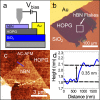Moiré-Modulated Conductance of Hexagonal Boron Nitride Tunnel Barriers
- PMID: 29913062
- PMCID: PMC6095635
- DOI: 10.1021/acs.nanolett.8b01223
Moiré-Modulated Conductance of Hexagonal Boron Nitride Tunnel Barriers
Abstract
Monolayer hexagonal boron nitride (hBN) tunnel barriers investigated using conductive atomic force microscopy reveal moiré patterns in the spatial maps of their tunnel conductance consistent with the formation of a moiré superlattice between the hBN and an underlying highly ordered pyrolytic graphite (HOPG) substrate. This variation is attributed to a periodc modulation of the local density of states and occurs for both exfoliated hBN barriers and epitaxially grown layers. The epitaxial barriers also exhibit enhanced conductance at localized subnanometer regions which are attributed to exposure of the substrate to a nitrogen plasma source during the high temperature growth process. Our results show clearly a spatial periodicity of tunnel current due to the formation of a moiré superlattice and we argue that this can provide a mechanism for elastic scattering of charge carriers for similar interfaces embedded in graphene/hBN resonant tunnel diodes.
Keywords: Boron nitride; epitaxy; growth; heterostructure; moiré; superlattice; tunneling.
Conflict of interest statement
The authors declare no competing financial interest.
Figures





References
-
- Yankowitz M.; Xue J.; Cormode D.; Sanchez-Yamagishi J. D.; Watanabe K.; Taniguchi T.; Jarillo-Herrero P.; Jacquod P.; LeRoy B. J. Nat. Phys. 2012, 8, 382–386. 10.1038/nphys2272. - DOI
Publication types
LinkOut - more resources
Full Text Sources
Other Literature Sources

